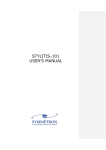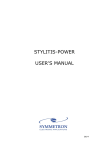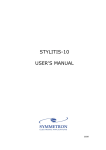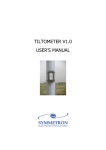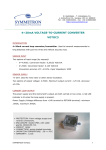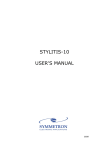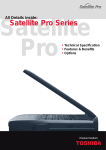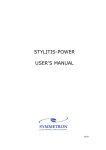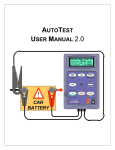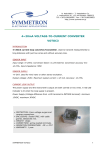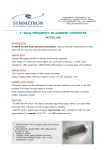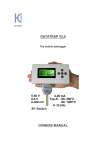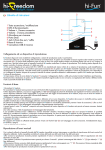Download Stylitis-4x User Manual 02/05
Transcript
STYLITIS-40/41 USER'S MANUAL Copyright 1998-2014, The Symmetron Company. Sixth Edition in English, June 2014. No part of this publication may be reproduced, stored in a retrieval system, or transmitted, in any form by any means, without the prior written permission of Symmetron Company. Information furnished by Symmetron is believed to be accurate and reliable; however, no responsibility is assumed for its use. No license is granted by implication or otherwise. Symmetron is a registered trademark and Stylitis is a trademark of the Symmetron Company. All other trademarks belong to their respective owners. WARRANTY The Symmetron Company warrants its products shall be free from defects on materials and workmanship under normal use for the period of 1 year. Symmetron's obligation under this warranty shall not arise until buyer returns the defective product, freight prepaid to Symmetron's facility or another specified location. The only responsibility of Symmetron under this warranty is, at its option, to replace or repair, free of charge, any defective component of such products. THE WARRANTY DOES NOT EXTEND TO AND SHALL NOT APPLY TO: 1. Products which have been repaired or altered by other than Symmetron's personnel, unless Buyer has properly altered or repaired the products in accordance with procedures previously approved in writing by Symmetron. 2. Products which have been subject to misuse, neglect, accident, improper installation, or direct lightning strikes. THE WARRANTY AND REMEDIES SET FORTH ABOVE ARE IN LIEU OF ALL OTHER WARRANTIES EXPRESSED OR IMPLIED, ORAL OR WRITTEN, EITHER IN FACT OR BY OPERATION OF LAW. THE SYMMETRON COMPANY SHALL HAVE NO LIABILITY FOR INCIDENTAL OR CONSEQUENTIAL DAMAGES OF ANY KIND ARISING OUT OF THE SALE, INSTALLATION, OR USE OF ITS PRODUCTS. RETURN OUTSIDE GREECE Contact Symmetron for authorization and shipping instructions. SYMMETRON ELECTRONIC APPLICATIONS TEL: +30-210-603-4002 FAX: +30-210-603-4003 e-mail: [email protected] Internet: http://www.symmetron.gr/ Made in Greece. 2 STYLITIS -41 USER'S MANUAL Σχόλιο [N1]: CONVENTIONS USED IN THIS MANUAL Symbol CAUTION Meaning To avoid injury of personnel and/or damage to the instrument the operator must refer to the user’s manual. Calls attention to a procedure or condition which, if not correctly performed could result in damage to the instrument. 1> Represents a menu item in the display. [1] Represents a key in the front panel N. Hadzidakis – T. Katsabakou Co. 34, Leontariou St. 15344 Pallini, Greece MANUFACTURER’S DECLARATION OF CONFORMITY I, the undersigned, hereby declare that the equipment specified conforms to the below Directives and Standards. Standards to which Conformity is Declared EMC Emmisions: ΕΝ55022, EN61000-4-3 EMC Immunity: EN61000-4-2, EN61000-4-4, EN61000-4-5, EN61000-4-6 Safety: EN61010-1 Description of Equipment Data recording and logging instruments. Model Stylitis-41 Batch of product covered Serial numbers: from 50 to 2000 Date and Place Pikermi, Attica, Greece, December 31, 2002. Authorized signatory on behalf of the manufacturer N. Hadzidakis Name: N. E. Hadzidakis Title: Director N. Hadzidakis – T. Katsabakou Co. STYLITIS -41 USER'S MANUAL 3 CONTENTS 1. INTRODUCTION ............................................................................. 6 2. USE & SAFETY ............................................................................ 10 3. USER INTERFACE & FUNCTIONS SUMMARY .......................... 11 4. POWER MANAGEMENT .............................................................. 13 5. MEASUREMENTS ........................................................................ 14 6. OUTPUTS ..................................................................................... 14 7. INPUTS ......................................................................................... 15 8. MATH PROCESSING ................................................................... 18 9. DATA STORAGE/RETRIEVAL..................................................... 19 10. RECORDING & FILING SYSTEM............................................... 21 11. DATA POST PROCESSING ....................................................... 22 12. DATA SAFETY ........................................................................... 23 13. PASSWORD ............................................................................... 24 14. COMMUNICATION VIA THE SERIAL PORT ............................. 25 15. SOFTWARE INSTALLATION ..................................................... 25 16. TECHNICAL SPECIFICATIONS ................................................. 26 APPENDIX A CONNECTION EXAMPLES................................. 28 APPENDIX B STYLITIS-41 MENU TREE ................................ 29 APPENDIX C STYLITIS-41 DATA RECORDING ...................... 30 APPENDIX D STYLITIS-41 GSM MODEM................................ 31 4 STYLITIS -41 USER'S MANUAL APPENDIX E STYLITIS-41 INTERNAL SETTINGS .................... 33 STYLITIS -41 USER'S MANUAL 5 1. INTRODUCTION Stylitis-41 is designed to make the collection of technical measurements easy and safe. As such, it allows you to: Communicate through the built-in display and keyboard. Connect various types of industry-standard sensors like Anemometers, Vanes, Pyranometers, Thermometers, etc. Program a time interval, over which the instrument will perform mathematical operations, including minimum, maximum, average and standard deviation. Store the results of operations in the internal buffer or in external removable Compact Flash memory cards. Use the serial interface to download buffer contents or as a substitute for the built-in display and keyboard. The above operations are performed simultaneously without affecting the integrity of the acquired data (refer to Figure 1). USING STYLITIS-41 The Stylitis family of data loggers can operate in several different ways, depending on your application (refer to Figure 2): 1. As a stand-alone unit. You can leave the logger unattended for weeks or months, conditioning and recording input signals. Data are compressed and stored in the internal buffer or in removable Compact Flash cards. If the card is not new or if it has not been used only in the specific datalogger, it induces the user to press button [1] to clear the card. Cards can be replaced without interrupting the acquisition process. Using the 6 STYLITIS -41 USER'S MANUAL supplied software (Opton 4) one can read the card via a Compact Flash reader and convert compressed data to ASCII text files organized in columns for further processing. 2. As a stand-alone unit with on-line data transfer. This is done by using the internal buffer as a storage medium. Data are transferred to the PC for further processing via the serial port. Connection between the logger and the PC can be done using a serial cable, a modem (wired or wireless) or a LAN. A COM port, a modem or an Ethernet adapter, respectively, is required on the PC. The supplied Stylitis software is used for the above operations, as well as, the conversion of compressed data to ASCII text files. 3. As an on-line front-end unit. It conditions, samples and transfers signals on-line to a computer for further processing and storage. The user’s program issues a command, which is used to transfer data. Connection between the logger and the PC can be done using a serial cable, a modem (wired or wireless) or a LAN. See 4. POWER… For a more detailed description read the following pages. Technical support is available at +30-210-603-4002 or e-mail address [email protected]. Internet site: www.symmetron.gr References: Stylitis-41 Installation Guide STYLITIS -41 USER'S MANUAL 7 Figure 1: Block Diagram SRAM LC Display Li Bat Real Time Clock Compact Flash Socket 3 counter inputs: C1~3 Keyboard ADC Internal Supplies Int. Bat. 6~15VDC Ext. Bat. Counter circuits CPU REG +5V Reference Input / Output Protection RS232 4 voltage or current inputs: AN1~4 3 pulsed voltage +5V outputs 2 fixed voltage +5V outputs Stylitis-40/100 Use a memory card to store and transfer data. PC Figure 2 Sensor 1 Compact Flash slot Memory card (Compact Flash) Compact Flash reader USB port Use a cable (up to 15 m) to set-up and transfer data. RS-232 port Sensor 2 Use a standard or cellular modem to set-up and transfer data. RS-232 port Internal memory buffer Sensor n Standard modem Modem GSM modem Base station Use a LAN (up to 200m) and TCP/IP to set-up and transfer data. Serial server STYLITIS -41 USER'S MANUAL Ethernet 10baseT adaptor 9 2. USE & SAFETY EXTERNAL DESCRIPTION. Front Panel Compact Flash memory card slot. Push the card in with the logo on the upper side. Liquid crystal display. CAUTION Do not: - destroy - overheat - short-circuit - charge dry cells. Keypad. RS232, D9Μ connector for connection to a PC, modem or Ethernet adapter. If the instrument will not be used for a long time, remove the dry cells. 2xPP3 (9V) cell drawers. To open the drawers pull out while pushing upside. Alkaline cells are recommended. 4x front panel screws. Remove to replace the power supply fuse. Box bottom-side (Terminal description inside box cover) Left Terminal Right terminal Ground bolt. It is connected to the internal instrument shield and measurement ground common. Usually connected to earth. FUSE REPLACEMENT. CAUTION The fuse used must of the specified rating. Never shortcircuit the fuse holder. The instrument uses a 315mA power supply fuse, which must be replaced if blown (supply voltage out of limits). It can be found on the bottom side of the main printed circuit board (see APPENDIX E), after removing the 4 screws that hold the front panel in place. Make sure you have removed the external supply and dry cells before attempting the replacement. 10 STYLITIS -41 USER'S MANUAL 3. USER INTERFACE & FUNCTIONS SUMMARY KEY SEQUENCE (See also APPENDIX C) The display and keyboard serve to: 1> | 1> Check firmware version. 1> | 2> Check battery voltage (due to a protection, diode internally the battery voltage measures about 0.6V less than actual value). The logger operates with internal voltages greater than 6.25VDC and less than 15VDC. 1> | 3> Check COMPACT FLASH card status and remaining capacity. COMPACT FLASH memory cards may be used to hold large amounts of data. See 9. DATA … 1> | 4> Check buffer status and remaining capacity. See 9. DATA… 1> | 5> Verify system activity. This is a summary of basic settings. 2> | 1> Select averaging interval. See 8. MATH… 2> | 2> Setup input parameters. See 7. INPUTS… 2> | 3> Setup Energy Save or Continuous logger operation mode. This menu also selects the ‘PC SYNC’ operation - see 4. POWER… 2> | 4> Enter the site identification in alphanumeric characters. Use the dot [.] to change the keyboard character set. 2> | 5> Display and change the internal Real Time Clock time/date (key-in new values). 2> | 6> Set/Clear the Password. Enter all zeroes to disable password. See 13. PASSWORD. 3> | 1> , 2> Display the current value of an input and the minimum, maximum and average of the last interval. STYLITIS -41 USER'S MANUAL 11 4> | 1> Download measurement data via the RS232 port - see 14. COMMUNICATION. 4> | 2> Check for existence of a modem. If a GSM modem is connected display network operator and signal level. See APPENDIX D. 4> | 3> Check a SIM card’s PIN. If ‘READY’ is displayed the SIM is ready for use, otherwise a valid SIM PIN is asked for. Then, the logger will unlock the SIM card. 5> Start or Stop ACQuisition. See 9. RECORDING… 12 To select a menu item use the corresponding numeric key. [ESC] goes one menu-level up and abandons changes. [ENTER] goes one menu-level up and saves changes. You can change parameters only when ACQUISITION is OFF. STYLITIS -41 USER'S MANUAL 4. POWER MANAGEMENT There are three operating modes: ENERGY SAVING MODE This is the default-operating mode. The unit is in standby mode and is awakened once per second to measure, calculate and store results. Since it actually operates only one 100th of the time this results in a longer battery life. This operation is invisible to the user since the LCD is off. Depressing a key for more than one second activates the display, enabling interface with the user. Stylitis-41 automatically reverts to standby mode if there is no key action for 1 minute. CONTINUOUS OPERATION MODE This mode holds the unit continuously activated, thus greatly reducing battery life. It is useful, though, if you want to continuously display an input. When set for continuous operation, Stylitis-41 does not automatically switch to standby mode. You will have to manually set the operation mode back to 'Energy Save'. PC SYNC MODE ‘PC SYNC’ enables on-line operation with a computer connected to the serial port. A user software can setup the logger and read measurement data in real-time. For more information refer to application notes AN40-3 and AN40-4. STYLITIS -41 USER'S MANUAL 13 5. MEASUREMENTS Stylitis-41 is capable of directly measuring voltage, frequency and events. With suitable sensors it is also capable of measuring: Wind speed, direction and wind-turbine power curves. Interfaces to virtually every type of anemometer and wind vane. Temperature, humidity, pressure. Solar radiation, rain height, water speed, etc. Sensors must provide either an analog voltage in the range of 0~5V or a frequency signal in the range of 0~5kHz. 6. OUTPUTS The vane supply outputs (+5V PULSED) may be used for excitation, as they are capable of supplying up to a TOTAL of Connection examples: 25milliAmps with an accuracy of 0.1%. One of the outputs (+VA PULSED) has selectable output voltage (see APPENDIX E). See APPENDIX A. Remember, however, that this supply is pulsed to conserve battery power. It is on for about 3mseconds every 1 second. Thus the average current drawn from the battery (in addition to the one listed in the specifications) is 1/300th the total Vane supply current. Similarly, the anemometer supply outputs (+5V FIXED) can CAUTION Do not apply an external voltage to the instrument outputs. supply up to a TOTAL of 10milliAmps with an accuracy of 5%. These outputs are not pulsed. Thus, the average current drawn from the battery is the same as the total Anemometer Supply Current. 14 STYLITIS -41 USER'S MANUAL 7. INPUTS To setup vane and analog input parameters: Select an input, 1-4. Then use the [] or [] keys to select an option. ANALOG INPUTS. The Analog to Digital Converter used has 4 inputs with a resolution of 12 bits and a range of 0~+5V. There are 4 options per input: 1. NOT USED. 2. User selectable SLOPE & OFFSET values are applied on acquired data: Scaled input = (slope x input voltage) + (offset). Math operations are performed on scaled inputs. These include minimum, maximum, average, standard deviation. CAUTION Do not apply a voltage exceeding the maximum permissible (20V) on voltage inputs. 3. VANE input, for wind direction measurements. An input voltage between 0V and 5V corresponds to an angle of 0~360 degrees with a resolution of 1.4 degree. Math operations include vector minimum, maximum, average, standard deviation. Vane math is NOT the arithmetic average; a vector-averaging algorithm is used to ensure true indication of angle averages. The user can freely set the zero degree point in degrees (0~359). This is the actual vane zero in respect to the north. For instance, if the vane “zero” mark is placed 30 east then you enter 30 as offset; if it is placed 30 west you enter 330 (=360-30) as offset. 4. TEMPERATURE PT100. The logger connects to a PT100 RTD temperature sensor as shown in APPENDIX A. STYLITIS -41 USER'S MANUAL 15 Linearization is performed internally throughout a range of -50C~+55C. Mathematics is performed as above. ADVANCED APPLICATIONS OF ANALOG INPUTS. INPUT 1: Analog input 1 (Α1) may record voltage at the input terminal or the logger’s internal power supply. Use the [-] key (in A1’s input setup menu) to select this option. The display shows INP or BAT. To record the battery or power supply value correctly you must enter slope=3.15 and Offset =0. This option allows recording of the battery-discharging history. NOTE: When BAT is selected to record power supply voltage, the internal A1 input is disconnected from the A1 external terminal. INPUTS 3 & 4: CAUTION Do not apply a voltage exceeding the maximum permissible (20V) on voltage inputs. Do not apply a current exceeding the maximum permissible (100mA) on current inputs. Analog inputs 3 & 4 may be connected to the input terminal block or use an amplifier with gain. Use the [-] key during the inputs’ setup to select this option. The display shows INP or GAIN. If you select GAIN remember that the slope and offset values are applied to the amplified signal. The amount of gain is set via plug-in resistors on the data logger’s main printed circuit board, and can be changed to accommodate gains up to 1000. These two inputs can also have a 20-Ohm input resistance for use with 4-20mA sensors. 16 STYLITIS -41 USER'S MANUAL To setup anemometer and counter parameters: Select an input, 1-3. Then use [] or [] to select option. From the TYPE menu press the corresponding numeric key to change anemometer or counter input type between Low Level AC (SIN) and Digital (TTL). COUNTING INPUTS. There are 3 16-bit counting inputs (0-65535 counts). There are 4 options per input: NOT USED. ANEM input. Selectable low level AC or pulse type. Input frequency (counts per second) is scaled with user selectable slope and offset values: Wind speed (km/h) = (slope x input frequency) + (offset). Math operations include minimum, maximum, average, standard deviation. Output (calculated) range: 0~400 user-defined units. Resolution is 0.1 units. Examples of units are m/sec, km/h, etc. The anemometer’s manufacturer gives slope and offset values. For instance, the NRG-Maximum #40, has a slope = 0.765 m/sec/Hz, and an offset = 0.35. FREQUENCY COUNTER. No slope or offset values are applied. Math operations include minimum, maximum, CAUTION Do not apply a voltage exceeding the maximum permissible (20V) on counter inputs. average. EVENT COUNTER. Counts events (pulses) per averaging period. STYLITIS -41 USER'S MANUAL 17 8. MATH PROCESSING The analog and counting inputs selected are measured and temporarily stored once per second. Averaging intervals are selectable at 1, 2, 5, 10, 15 or 60 minutes. Following the completion of an averaging interval, the math functions are performed and the results are stored in the internal buffer or the COMPACT FLASH card. See also, 7. INPUTS… Math calculations include minimum, maximum, average and standard deviation. The standard deviation is calculated using the formula: SDV = x2 n AV 2 , where n is the number n n 1 of the samples and AV the average of the samples in the averaging interval. Stored data format for the various input types is: ANEM FREQ ANALOG VANE ANALOG Minimum xxx.x xxx xxx.x xxxx.xxx Maximum xxx.x xxx xxx.x xxxx.xxx Average xxx.xx xxx.x xxx.x xxxx.xxx SDV xxxx.xxx xxx.x xxxx.xxx The stored data have are marked with a time stamp for extra protection. The time stamp marks the end of the statistic interval. 18 STYLITIS -41 USER'S MANUAL 9. DATA STORAGE/RETRIEVAL Three types of storage media can be used, each one having its own strengths and weaknesses. INTERNAL BUFFER. The internal buffer's size of 512Kbytes is enough for several applications. For example, to record data using one counter input and one analog input, with a 10min-averaging interval, it will suffice for 212 days. A memory card is NOT permanently required, thus reducing operating costs. Data can be retrieved two ways: 1. By placing a suitable memory card, for a few seconds, (see below) in the slot. Data are transferred to the card and recording continues uninterrupted. During the acquisition in the internal buffer (with no card), you can put a card in the datalogger and clear it, if it is not clear, via the [1] button. Only after that data will be able to be recorded in the card. Then, the data which have already been recorded in the internal buffer will be transferred in the card almost immediately. That is, either the ‘CARD ERASED ok’ message will appear in the datalogger’s screen, in case you clear the card, or the message indicating its size will appear, along with an ‘ok’. Right next, the ‘TRANSFERING DATA’ message will appear. When it disappears, you can remove the card. If you do not,, the file which has been created in the card, and contains these data, will continue to be recorded. μεταφερθούν στην κάρτα, αλλά θα παραμείνουν στην εσωτερική μνήμη. 2. By downloading buffer contents through the serial port (see SERIAL PORT). ADVANTAGES: Low Operational Costs. DISADVANTAGES: Restricted size. Data loss in case of power supply loss. STYLITIS -41 USER'S MANUAL 19 COMPACT FLASH MEMORY CARDS The size of the above cards is enough for virtually all applications. (E.g. for data of one anemometer and one windvane, with a 10 minute interval, a 256 Μbytes card will last for 3737 months). Each time a new card is inserted in the datalogger, it must be cleared. The datalogger warns you with the corresponding message and induces you to do so by pressing the [1] button. Τhe card is recognized and initialized by inserting it into the Stylitis-41 slot. A header is put on it including a serial number, the site name and the insertion time. Therefore, if you remove the card and re-insert the same one later, it will be recognized by the datalogger and you will not need to clear it. By inserting the card in the slot of a Compact Flash card reader, connected to a computer USB port, data are retrieved via the Opton 4 software. 20 ADVANTAGES: High capacity. Low cost. No Battery. DISADVANTAGES: None. STYLITIS -41 USER'S MANUAL 10. RECORDING & FILING SYSTEM When acquisition Starting (ON) acquisition means: is on: No parameter change is allowed. 1. Open a new file on a memory card (if one exists). 2. Start recording with the set parameters. Stopping (OFF) acquisition means: When acquisition is off: Parameter change is 1. Stop recording. allowed. 2. Close the file on a memory card (if one exists). 3. Clear the internal buffer. When using memory cards keep in mind the following tips: 1. Multiple files (acquisition sessions) can exist on the same card. If you stop the current acquisition and start a new one, a new file is created with a new number and a new start date and time. 2. Full cards are replaced without loss of data and without turning OFF the acquisition. In the meantime, data are kept in the buffer. 3. Accidentally removing and reinserting a card does NOT result in data loss. The system recognizes it is the same card and (provided there is space) continues storing data in a new file. 4. Only the lastly inserted card is recognized by the system. You can withdraw and reinsert the same memory card as many times as you wish. But changing the Compact Flash card means that recognition and initialization of a card is done only if the card is new and not used. Otherwise, the datalogger induces you to clear it by pressing the [1] button (refer to: 9. DATA STORAGE…). STYLITIS -41 USER'S MANUAL 21 11. DATA POST PROCESSING A card’s recorded data are transferred to a PC for processing when you insert the card to the slot of a Compact Flash card reader, connected to a computer USB. To save space, data are stored compressed. Moreover, the data can be retrieved directly from the datalogger, via its serial port, either locally or via modem (see 14. SERIAL PORT). Via Opton 4 software, you can download data either from the internal buffer or from the card (if there is one). When you download data from the internal buffer, (with no card), with acquisition ON, after the download, Opton 4 asks you if you wish to clear it or not. In the second case, the recording will be continued, by incrementing the size of the internal buffer’s data file. The ‘BUFFER REMAINS’ message will appear in the datalogger’s screen. When you download data from the card, there are two options: 1. To download a previous file, by typing its number in the Opton 4’s window. In this case, if the acquisition is ON, then the recording in the current file continues uninterrupted (it is not affected by the download). 2. To download the Compact Flash (files) Directory. Afterwards, you may mark specific files from the directory to download. Again, if the acquisition is ON, then the recording in the current file continues uninterrupted (it is not affected by the download). 3. To download the most recent file (‘Most recent file’ option). In this case, if the acquisition is ON, the file closes before it is downloaded and then it is downloaded. After it has closed, a next file opens (is created), in which the acquisition continues. Data records are decompressed to columns using Opton 4, the PC program that comes with the unit. Further data manipulation and processing is possible using standard available software like Excel, Axum, etc. Optional software suitable for Wind/Meteorological analysis is also available. It accepts the decompressed output and produces graphs, tables, etc. in industry-standard format. Please contact Symmetron for details. 22 STYLITIS -41 USER'S MANUAL Windrose graph 5 11 wind speed (m/s) 17 23 NNE ENE ESE WSW WNW SSE SSW Turbulence Intensity (%) 18 16 14 12 10 8 6 4 2 0 NNW Wind Direction 12. DATA SAFETY To ensure correct data acquisition and protect stored data and settings the power supply is continuously checked. If battery voltage is found to be less than 5.25V, acquisition stops. The acquisition restarts when battery voltage rises above 5.75V. If battery voltage falls below 5.15V the system shuts down and stops responding to external stimulus. STYLITIS -41 USER'S MANUAL 23 13. PASSWORD Stylitis-41 allows you to set a password in order to permit access to it from qualified persons only. Using the SETUP> PASSWORD menu enter an alphanumeric word of up to 8 characters long (press [.] to enter alpha characters). Password protection starts after the password is set and Stylitis enters Energy-Save mode. Any attempt to wake-up the data logger will result in asking for the password. If the correct password is not supplied within 4 tries, the logger will lock-up and can only be unlocked by Symmetron (either locally or remotely). To disable the password protection you must enter 8 dashes [-] or zeroes [0]. 24 STYLITIS -41 USER'S MANUAL 14. COMMUNICATION VIA THE SERIAL PORT To connect to a standard PC serial port a The RS-232 serial port comes as standard with Stylitis-41. It allows local or remote set-up and buffer data retrieval. The user "straight" type interface, as appears on the PC screen is identical to that on the cable is required, data logger. i.e. one which connects pin 2 of The connector is a DB9Male with the following pin assignment: one connector to PIN 2 Transmit pin 2 of the PIN 3 Receive cable connectors PIN 5 Ground must be female. Communication speed is fixed at 9600 baud with 8 data bits, 1 other etc. Both stop bit and no parity bit. For the communication of Stylitis and the PC, connect the datalogger’s serial port to a computer COM port via a DB9F to DB9F (female-female) straight cable. Next, run the Opton 4 software, by creating a local connection via the specific COM port to communcicate with the datalogger. You can also use a modem, by connecting it to the serial port via a NULL MODEM cable for remote communication with Stylitis (see APPENDIX D). Furthermore, you can use Symmetron’s Symo-net, by connecting the datalogger’s serial port to the DEVICE 1 port of the Sym-o-net, via a NULL MODEM DB9F to DB9M (femalefemale) cable. In this case, create a remote Diameson (GPRS client) connection via Opton 4. For further information about the Sym-o-net and its settings and capabilities, please refer to its User Guide. 15. SOFTWARE INSTALLATION For software installation and using instructions refer to the README.TXT file on the 1st diskette or CD supplied with the unit. STYLITIS -41 USER'S MANUAL 25 16. TECHNICAL SPECIFICATIONS ANALOG ΙNPUTS (individually selectable) 4, 12-bit each. Input range: see table. Input impedance 10ΜΩ. Amplification option on A3 and A4: resistor-set gain 2 to 1000. Resolution (SLOPE, OFFSET): 1.22mV. VANE resolution: 1.4 degrees. Temperature resolution (PT100): 0.3C. Maximum continuous voltage input: 20V Current measurement option on A3 and A4 (w/Gain=12.5): Accuracy (0.2%) + (20μΑ). Input impedance 20Ω. Maximum continuous current input: 100mA INP Range: 0~+5V A1 A2 A3 A4 (0.1% Rdng)+ (4mV) (0.1% Rdng)+ (4mV) (0.1% Rdng)+ (4mV) (0.1% Rdng)+ (4mV) Accuracy referred to input SLOPE, OFFSET GAIN (2~1000) BAT Range:0~+5V/Gain - PT100 INP GAIN Range: Supply Voltage 0.6C +0V, -0.6V - - - 0.6C - (0.15% Rdng)+ (4mV/Gain)+ (300μV) (0.15% Rdng)+ (4mV/Gain)+ (300μV) - 0.6C - - 0.6C - VANE INP GAIN 1.4 deg 1.4 deg 1.4 deg - 1.4 deg - - COUNTER ΙNPUTS (individually selectable) 3, 16-bit each. Resolution: 1 count. Accuracy: 1 count. Input range: 0~5kHz. Input impedance: 1ΜΩ. Sensitivity: 200mVp-p or better. Maximum continuous voltage input: 20V OUTPUTS (SENSOR SUPPLY) 3, pulsed 5V. Maximum total output current: 25mA. Accuracy 0.2%. 2, fixed 5V. Maximum total output current: 10mA. Accuracy 5%. Optional: pulsed +12/+18V (current-loop sensor supply). Maximum output current: 20mA. Accuracy 10%. Requires the addition of an integrated circuit and the setting of certain jumpers. Maximum continuous time, short-circuit to Ground: indefinite. PROTECTION All inputs/outputs, with spark gap arrestors and high-speed diodes. SENSOR EXAMPLES Anemometers, vanes, pyranometers, thermometers, rain level, water level and speed, barometric pressure, pulse counting, voltage, frequency, etc. DATA STORAGE INTERNAL BUFFER: 512Kbyte). Typical capacity (1 analog and 1 counting input, 10 min averaging): 212 days. Compact Flash MEMORY CARDS: up to 2Gbytes, FAT16 formatted. 26 STYLITIS -41 USER'S MANUAL DATA PROCESSING Individually programmable slope and offset for each input. Sampling @ 1 Hz. Calculation and storage of Minimum, Maximum, Average and Standard Deviation selectable @ 1, 2, 5, 10, 15 or 60 minute intervals. Real Time Clock with automatic lap year correction. Accuracy: 1 minute/ month. SERIAL PORT PROGRAMMING AND DATA TRANSFER: RS232C port. 9600 baud, 8 bits, no parity, 1 stop bit. Socket is DB9M. POWER SUPPLY INTERNAL BATTERY: 2x9V alkaline- typical life 2 months (Math mode, 10-min intervals). EXTERNAL: 6~15V, DC/AC typical consumption 500μΑ (LCD off) or 35mA (LCD on). Power consumption doubles when the +12/18V output is activated. Maximum continuous power supply voltage: 18V OPTIONAL: PV panel and internal rechargeable battery. VARIOUS ENCLOSURE: ΙΡ65 sealed. DIM: 31x21.5x17.5cm WEIGHT: 4kg. CONNECTORS: Removable screw terminal strips on bottom. OPERATING/STORAGE TEMPERATURE: -30C~ +70C LCD OPERATING TEMPERATURE: 0-50C WARRANTY: 1 Year. STYLITIS -41 USER'S MANUAL 27 APPENDIX A CONNECTION EXAMPLES BOTTOM SCREW TERMINALS 1 2 3 4 5 6 7 8 9 10 ANALOG4 GROUND ANALOG3 +5V PULSED GROUND ANALOG2 +5V PULSED GROUND ANALOG1 +5V PULSED EXT. BATT- EXT. BATT+ GROUND RIGHT COUNTER3 +5V FIXED GROUND COUNTER2 +5V FIXED GROUND COUNTER1 LEFT 1 2 3 4 5 6 7 8 9 10 PT100 RTD ANALOG VOLTAGE DIGITAL TYPE ANEMOMETER 350Ω/0.1%,5ppm LOWLEVEL (AC) ANEMO METER POTENSIOMETRIC VANE GROUND BOLT REED SWITCH RAIN GAUGE SAFETY EARTH + EXTERNAL POWER SUPPLY: VOLTAGE REGULATOR + + 12V EXTERNAL LEAD-ACID BATTERY SOLAR (PV) PANEL OUTPUT: 15~18V 6-15V DC 5-12V AC (OPTIONAL) (OPTIONAL) (OPTIONAL) REFER TO TECHNICAL SPECIFICATION PAGE FOR INPUT SPECIFICATIONS. 28 STYLITIS -41 USER'S MANUAL APPENDIX B STYLITIS-41 MENU TREE Press any key for main menu. STATUS: 1>INFO 2>BAT 3>CARD 4>BUF 5>ACTIVITY 1>STATUS2>SETUP3>DISPLAY 4>SERIAL LOAD 5>ACQ on/off 5>ACTIVITY 1 To check Software version. To check battery voltage. 1 To see system status. 2 2 To set system parameters. 3 3 To display inputs To get card type and free space. To clear card. (1) 4 To get internal buffer free 4 To download buffer-data via RS232 to PC. 5 To Start or Stop acquisition (recording) of data. space. 5 To check system current activity: To accept press [ENTER]. SETUP:1>RATE2>IN 3>MODE 4>SITE 5>TIME 6>PASSWORD 1 To select averaging interval. 1>ANALOG 2>COUNTER3>TYPE (1) 1 3 To select continuous or energysave operation. 2 (5) (alphanumeric) . 6 To set the password. 3 To select a menu item use the corresponding numeric key. [ESC] goes one menu-level up and abandons changes. [ENTER] goes one menu-level up and saves changes. You can change parameters only if ACQUISITION is OFF. To setup anemometer and counter parameters. Select an input, 1-3. Then use [] or [] to select option: Not used Anemometer slope, offset (3) Frequency counter Event counter 5 To set time and date. To setup vane and analog input parameters. Select an input, 1-4. Then use [] or [] to select option: Not used Vane input(2) Analog input slope & offset(3) 2 To setup input parameters. 4 To give a site name ACQuisition ON or OFF Averaging Interval (INT xx') Storage medium. To select C1, C2, C3 input (4) signal type: SIN for low-level AC source. TTL for digital source. NOTES: (1) Use [ ] or [ ] to select. (2) Use [—] to select vane zero point. (3) Use [1] or [2] to select fields. (4) Press corresponding numeric key to change anem or counter type between Low Level AC (SIN) and Digital (TTL). (5) Press [.] to use numerals as letters. STYLITIS -41 USER'S MANUAL 29 APPENDIX C STYLITIS-41 DATA RECORDING DATA RECORDING WITH A CARD ON ACTIVITY DISPLAY ACQ ON Data in card Data are stored in card. If the card is full, data are stored in internal buffer. Data recording (acquisition) is stopped when buffer is full. ACQ ON Data in Buffer Card full ACQ ON Card full Buffer full Insert a new card to get data from buffer. Recording continues with no interruption. If buffer was full, recording starts automatically again as a new session. DATA RECORDING WITH NO CARD ACQ ON Data in Buffer No Card Data are stored in internal buffer. Data recording (acquisition) is stopped when buffer is full. To get data from buffer: Insert a card, or Use SER'L LOAD command from main menu to send data via RS232 to a PC. Recording continues with no interruption. If buffer was full, recording starts automatically again as a new session. 30 ACQ ON No Card Buffer full WHEN ACQUISITION IS TURNED OFF: Buffer is cleared from data. File on card is closed. Data recording is stopped. WHEN ACQUISITION IS TURNED ON: A new file is opened on card. Data recording starts. STYLITIS -41 USER'S MANUAL APPENDIX D STYLITIS-41 GSM MODEM Using the SIEMENS TC35T MODEM Stylitis-41 is capable of supporting remote communication over the cellular (GSM) network. Using the Stylitis operation program all of the data logger’s functions are available without moving from your office. A data-only subscription to a GSM900/1800 network operator is also required. In this case, the logger’s menu includes the following options: 1>STATUS 2>SETUP 3>DISPLAY 4>COMMUNICATE 5>ACQ on/off 4 1>DOWNLOAD DATA 2>MODEM 3>PIN 1 Data download. 2 MODEM Stylitis-41 connected to a non-GSM (standard) modem GSM: “PANAFON: SIGNAL: 21 BER:0 Network and signal (Level and Bit Error Rate) information are displayed when a GSM modem is detected. Modem operation status. 3 Enter PIN/PUK for GSM modem READY PIN:_________________ READY indicates that the PIN number has already been entered correctly. SIM PIN PIN:_________________ Enter the PIN number. Press [ENT] to accept or [ESC] to cancel. SIM PUK PIN:_________________ After entering a wrong PIN for 3 times, you are asked to enter the PUK followed by a dot [.] and a new PIN. Example: 76878899.1200 (PUK, PIN) STYLITIS -41 USER'S MANUAL 31 CONNECTIONS OF STYLITIS-41 WITH GSM MODEM AND BATTERY. SOLAR CELL ~17V + - YELLOW BLACK Stylitis-40 + - CHARGE REGULATOR + - FLAT CABLE (Allows cover closure) GSM 900/1800 ANTENNA (VERTICAL ELEMENTS) BLACK 12V EXTERNAL RED + LEAD-ACID BATTERY OR 8~28Vdc POWER SUPPLY GSM MODEM MODEM TYPES AND SETUP 1. TC35T MODEM Disconnect the modem from the power supply. Press the yellow button on modem’s side, take out the drawer and place the SIM card (after unlocking it via a standard cellular phone). Connect the power supply to the modem. The green light should start blinking rapidly and after a few seconds, it should start blinking slowly. Finally, go to the COMMUNICATE>MODEM menu ([4]>[1]): the network operator’s name and the signal strength (SIGNAL) should appear in the display. BER shows errors (0 or 99 is OK). 2. M20T MODEM Follow the same setup instructions with the TC35T MODEM. 3. WAVECOM M1206/1306 MODEM Follow the same setup instructions with the TC35T MODEM, with the following differences: The button on modem’s side is black , while the modem’s light is red instead of green. 4. SYMMETRON SYM-O-NET Disconnect the modem from the power supply and place the SIM card (after unlocking it via a standard cellular phone). Connect the power supply to the modem. In the beginning, all 4 red LEDs will flash continuously, while the green LED (MODEM STATUS) should blink rapidly After half a minute or so (with default settings), the MODEM and DEVICE1 LEDs will flash continuously, while the green LED should blink slowly. Finally, connect the datalogger to the DEVICE 1 serial port and go to the COMMUNICATE>MODEM menu ([4]>[1]): the network operator’s name and the signal strength (SIGNAL) should appear in the display. BER shows errors (0 or 99 is OK). 32 STYLITIS -41 USER'S MANUAL APPENDIX E STYLITIS-41 INTERNAL SETTINGS 1. Analog channels A3 and A4 can be set to have GAIN (see 6. INPUTS). The gain factor of Α3 is given by: GAIN = R65 R66 R66 Example 1: R65=115000 Ohm, R66=10000 Ohm. Then GAIN = 12,5 Example 2: R65=100000 Ohm, R66=100 Ohm. Then GAIN = 1000 The gain factor of Α4 is given by: GAIN = R67 R68 R68 The resistors are placed on the main Printed Circuit Board (see picture). To uncover the Printed Circuit Board remove the 4 screws from the logger’s front panel. NOTE: A signal requires GAIN when its full-scale value is much less than the 5V input range. For example, when a transducer has a maximum output of 100mV then a GAIN of 50 is appropriate (50x0.1=5V). Thus, you preserve high resolution of measurements. STYLITIS -41 USER'S MANUAL 33 2. Analog channels A3 and A4 may be set for an input impedance of 20 Ohm. This, together with a GAIN equal to 12,5 (see above) makes these inputs suitable current loop (0~20 or 4~20mA) sensors. In older Stylitis-41 models, this is accomplished by placing 20 Ohm, 0.1% resistors at position R7 (A3) and R8 (Α4) on the main PCB. Newer models come with R7 and R8 preinstalled. The 20 Ohm input impedance for A3 and A4 is selected by placing a jumper on headers J10 and J11 respectively (J10 and J11 are found in place of R7 an R8). 3. The +VA PULSED output is normally set for a voltage of +5V, 0.1%, the same as the other outputs. Alternatively, it is possible to output +12V or +18V for current-loop sensor supply (this setting increases the logger power consumption by about 50%). This is accomplished by placing 2 integrated circuits (ΜΑΧ662Α στο U11 και LP2951CN στο U16) on the main PCB. Jumpers JP1 and JP2 must also be set as in the following pictures: +VA PULSED OUTPUT: +5V, 0.1% 34 STYLITIS -41 USER'S MANUAL +VA PULSED OUTPUT: +12V, 5% +VA PULSED OUTPUT: +18V, 10% STYLITIS -41 USER'S MANUAL 35



































